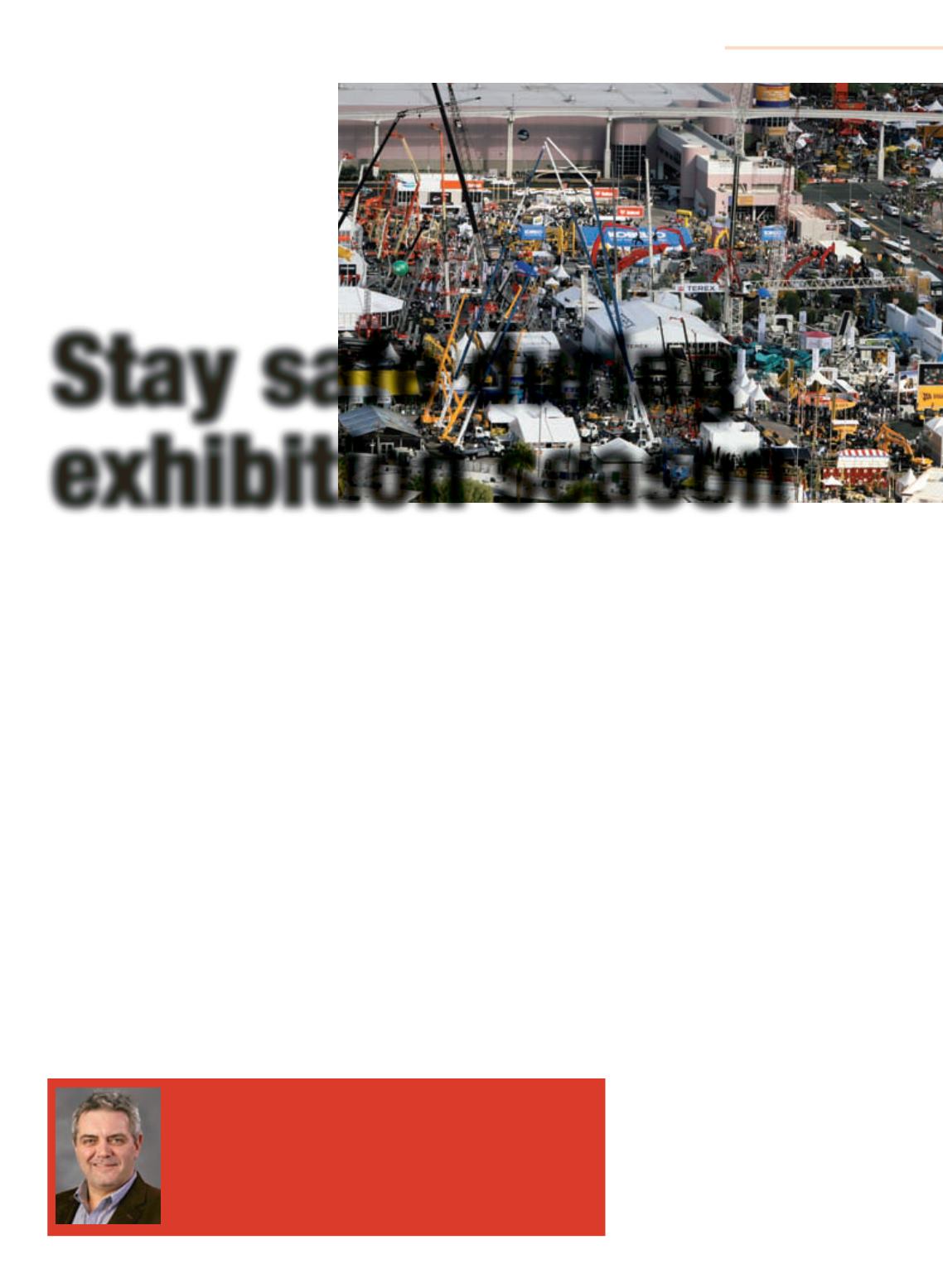
47
JANUARY-FEBRUARY 2014
ACCESS, LIFT & HANDLERS
THE AUTHOR:
Kevin O’Shea is the director of safety and training at Hydro-Mobile. He has
worked with Mastclimbers LLC, JLG, SGB, Lavendon and Mastclimbers LTD UK
(now Harsco). O’Shea serves as Chairman of IPAF’s North American Council,
Chairman of the SAIA’s MCWP Committee, is a member of the SAIA/OSHA
Alliance Team and has won various awards over the years, including: IPAF
Safety Champion 2009, 2010 and 2013; SAIA Council Chairperson of the Year
2009 and SAIA ‘Coupling Pin’ Award 2010.
Kevin O’Shea
, director of
safety and training at Hydro-
Mobile, reminds the industry
not to ruin a great show with
bad safety practices.
A
s we find ourselves on the threshold
of a busy exhibition season – World
of Concrete, The Rental Show and
ConExpo all occur in the first quarter of 2014
– it’s important to remember that safety is of
paramount importance.
Exhibitions are difficult environments to
control. The primary purpose is to sell, and
selling involves product demonstrations, and if
the exhibition stand and the show are buzzing,
you need eyes in the back of your head.
Additionally, remember who could walk on
to your stand unannounced – OSHA personnel,
local inspectors, magazine journalists, potential
customers – and ask yourself what it says
about your company’s credibility if you have an
uncontrolled, unsafe exhibition stand.
Here’s a list of important things to consider.
It’s by no means exhaustive, but as you
consider the points below it might lead you to
think about other aspects of safety.
Set-up
Make sure you have qualified personnel setting
up your stand space. Booms and scissors, for
example, require qualified operators, and mast
climbers require qualified installers.
If exhibition hall employees are contracted
to assist in the set-up process (e.g. forklift
operators) they should be qualified, and you
and the forklift operator must be able to
communicate using standard hand-signals.
Check your stand space for anything that
might affect stability, e.g. drainage channels,
and make sure you use proper cribbing to
spread the load under any jacks.
Make sure you control your stand space
during set-up, use danger tape to protect your
area. If you are setting up an outside stand
space, remember to pay attention to wind
speed. Bring your equipment down overnight
and remove keys. Inspect your equipment
before you set it up, but not just for cleanliness
and paint finish, make sure the equipment is
fully functional, and that all safety systems
operate properly. Ensure you have the correct
fall protection equipment available for use.
Consider who will be visiting
OSHA staff and state regulators are likely to visit
your stand and they will be particularly attuned
to unsafe behavior. Remember, they are on
your exhibition stand to see the latest your
industry has to offer, not the worst.
You might know your customers, but you don’t
know their children! We’ve all been talking to
customers while their offspring are climbing all
over equipment. It’s your job to control them
while they are on your stand. Apart from the
legal implications of an injury to child, think
about what it would do to the relationship you
have with your customer.
Stay safe during
exhibition season
SAFETY OPINION
Photographers are another challenge, they
continually want to get up above the show area
in a boom or a scissor, or a mast climber to
photograph the scene. Do they know how to
behave in the platform? If they are in a boom
lift do they have a full body harness on with
restraining lanyard? Are they likely to lean
over the controls without warning to get the
right photograph, creating the possibility for
involuntary operation? TV crews sometimes
want to go up in the platform with elaborate
systems, what’s the weight of their equipment?
Is the base area around your equipment
cordoned off? Scissors, boom lifts and mast
climbers could create a crushing hazard and
exhibition visitors might be oblivious.
Is the sales staff qualified?
Are some of your customers, or potential
customers, experienced operators who like
to ‘show-off’ their skills to their colleagues or
family? This has been a problem at exhibitions
for decades and a reminder to the operator that
he or she should demonstrate how to safely
operate the equipment can work wonders.
During the Show
A qualified person from your company, with
the right level of authority, should be in charge
of making sure that the stand space is well-
organized, safe and professional.
This person should ensure equipment is
brought down each night, with keys removed
and stored. The equipment should be inspected
each morning before the show begins.
Exhibition staff should be aware of their
responsibilities, and should be well organized,
only demonstrating the equipment if they are
properly qualified.
Here’s to a profitable and safe exhibition
season.
■
ConExpo, pictured here in 2011, is one of the
largest global construction trade shows.


